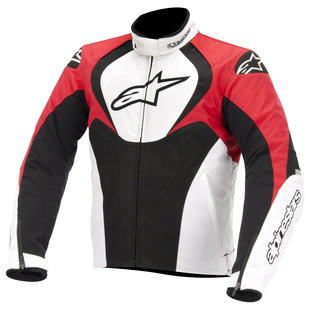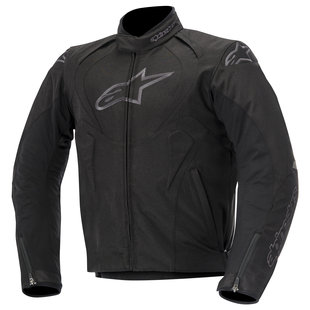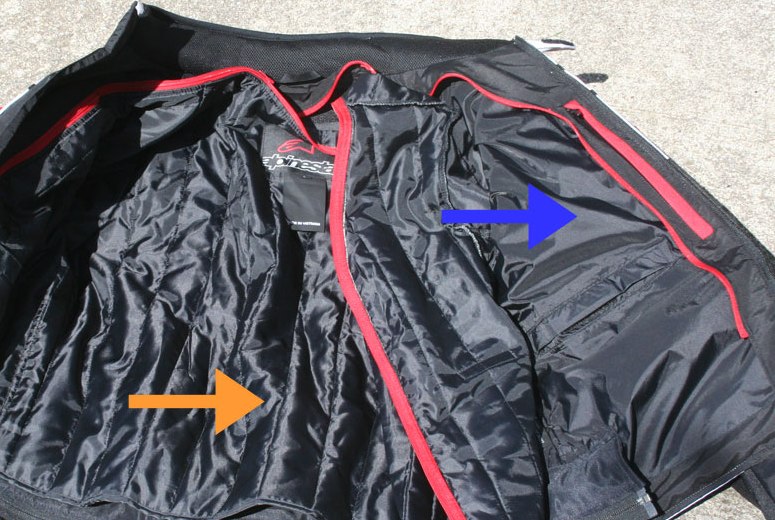I have more than my fair share of Alpinestars gear. From my old faithful roadrace boots and one-piece leathers to a pair of SP-1 gloves, two textile jackets, a mesh jacket and pants. If you plot all those products on a spectrum of my level of satisfaction, a pattern emerges. The more track-oriented stuff, I’m content with. That’s why I’m still wearing those old boots and leathers, even though I probably should retire them. The least satisfactory of the products are the two textile street jackets.
The Alpinestars T-Jaws WP is a sporty textile jacket that is comfortable in a sport bike tuck or on an upright bike like my Versys.
The newer of those is a T-Jaws WP jacket I’ve now been wearing for more than a year, in all kinds of weather and temperatures. Is it a failure? Not at all. But it makes sense for a smaller slice of riders than I expected when I first started testing it. Read on for all the details.
The T-Jaws WP is a textile version of the leather Jaws jacket by Alpinestars. Add the T for textile and the WP for waterproof. The shell is a mixture of nylon and polyester and is lined with Alpinestars’ proprietary waterproof and breathable liner material, called Drystar, which is not removable. There is a thermal liner that zips all around and snaps in the ends of the sleeves. CE-approved armor at the shoulders and elbows is supplemented by soft foam pads in the chest and a foam back protector. I upgraded to the Alpinestars Nucleon KR-1i back protector, which is CE Level 2-certified, and I can quickly switch it to whichever Alpinestars jacket I’m wearing on a given day. I haven’t crashed in this jacket, but for just $80, the KR-1i feels like a huge upgrade in protection over the flimsy foam pad.

The Alpinestars T-Jaws WP jacket.

The T-Jaws in all black.
The T-Jaws WP comes in four color combinations of black, white and red, ranging from all-black to the brightest black/white/red version that I’m wearing. The red is bright almost to the point of being fluorescent, so while it’s not high-vis, it’s pretty eye-catching and may help drivers notice you. The jacket also has five patches of reflective material on the back and the elbows.
Things I like about the T-Jaws WP
The first positive I have to mention is that this jacket is comfortable. The cut is sporty but not extreme. I rode bolt upright on my Kawasaki Versys and tucked in on my Triumph Daytona 675 with its low clip-ons and the jacket never felt restrictive or binding. Expansion panels on the back help. Plus, it feels lightweight but not flimsy.
Perhaps the attribute I most appreciate about the T-Jaws WP is that it is one of the warmest jackets I’ve owned. For winter riding, I zip in the thermal liner, cinch down the waist adjustments to prevent drafts and I’m as comfortable as this tropics-loving motorcyclist is going to get.
I like the wrist closures, which use a combination of hook-and-loop adjusters and zippers. Set the hook-and-loop once and open and close with zippers. It’s a convenient system and ensures the hook-and-loop material won’t wear out from daily use.
I like having pockets on both the inside of the jacket and inside the thermal liner for items like a smartphone that I want to keep protected inside the waterproof layer.
What I don’t like about the T-Jaws WP
First and foremost, the T-Jaws WP doesn’t live up to the WP in its name, by my standards. I ride year-around and in all kinds of weather, and the reason I buy textile jackets for street use is because I don’t want to have to carry a rain jacket with me, as I do with a leather jacket.
The good news is that the Drystar lining does not let water through. The bad news is that the main zipper on the T-Jaws WP is a weak point Alpinestars didn’t even try to address. There’s no rain flap over it, no rain gutter underneath. So in a brief shower, the T-Jaws WP will keep you dry. Ride in three hours of rain on the highway, as I did one day in this jacket, and expect to have a lot of water seep through the zipper. That can be annoying on a mild day, but it can be downright dangerous in cold weather. Plus, the zipper is a weak point when it’s cold and dry, as well as when it’s rainy. Though the jacket is warm, as I noted above, I feel a cold strip down my chest where there’s no insulation behind the zipper.
The second drawback is no big deal to me, but will matter to some people. I wear a mesh jacket all summer long (my Alpinestars T-GP Pro Air jacket is my favorite piece of Alpinestars street gear) and so for me the T-Jaws WP is a three-season jacket. For those who want to buy one jacket that does it all, the T-Jaws WP doesn’t have the venting you need for hot weather. The two 3.5-inch vents at the shoulders move more air than I expected, but they only allow air to circulate between the shell and the waterproof liner, not to your skin, so the cooling effect ranges from minimal to none. I wore the T-Jaws on a recent trip to the West Coast where one day I saw 41 degrees at 8 a.m. and 94 degrees at 3 p.m. The lightness of the jacket made the heat bearable, but you should basically consider this jacket to have no venting.
Finally, while I appreciate the visibility of the bright red and the large sections of white on the version I have, keeping it clean requires frequent attention. And I wish Alpinestars hadn’t used white on the neck. It invariably rubs against my helmet and gets smudged.

The blue arrow points to the Drystar waterproof lining, which is not removable. The orange arrow points to the removable thermal liner, which zips all around the front of the jacket.
A note on sizing
This jacket is generally consistent with other brands. I am 5 feet, 11 inches tall and weigh 170 pounds, so I wear a large in most jackets and can wear a medium in jackets with a generous cut. The T-Jaws WP in size large fits me on the loose side. With the thermal liner in, I still have room for another layer underneath, on those sub-freezing days. On hot days, the looseness helps compensate for the lack of venting. I could probably wear this in a medium, too, but the sleeves might be a bit short.
The jacket has a sporty cut, but you don’t have to be a buff bodybuilder to wear it. I measured the jacket with the waist adjusters fully loosened and my size large T-Jaws measured 40 inches around the waist.
The verdict
Who will like the Alpinestars T-Jaws WP? If you’re a sport rider who doesn’t intentionally set out for a long ride in foul weather, but you want a waist-length jacket that will keep you dry in an unexpected shower and will keep you warm in three-season (fall, winter, spring) use, the T-Jaws is a comfortable, protective (especially with the upgraded KR-1i back protector) jacket that makes sense and costs well under $300.
If, however, you’re a hardcore commuter or a long-distance touring rider who sets out in all kinds of weather and absolutely needs to stay dry, then you should step up to a jacket with more technical features to keep out the rain. Similarly, if you’re the type of rider who wants a single jacket that provides true four-season performance in all conditions, then you’ll want to choose a jacket with better venting.
